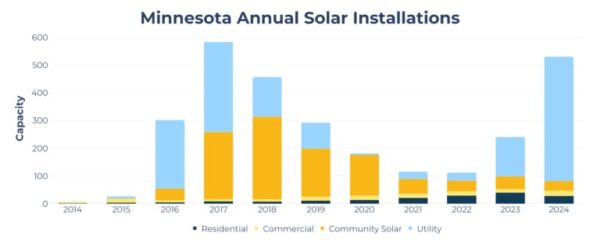As Minnesota’s permitting process is hindering rooftop solar growth, a report found, a bill to adopt automated solar permitting lingers in the state house.
Minnesota lawmakers are considering a bill to require local cities to adopt instant permitting for residential solar installations.
The bill, which only applies to local governments with populations of 5,000 or more, cuts down on inspections by only requiring one inspection for projects that were submitted through the permitting act, unless, of course, the first inspection failed. Notably, they would also be required to provide an option for a remote inspection via recorded video or photo. The fees for virtual inspections may not cost more than for in-person inspections.
Minnesota’s inconsistent and resource-intensive permitting processes are hindering the growth of rooftop solar, according to a report from the Institute for Local Self-Reliance (ILSR), making it “harder, slower and more expensive” for Minnesotans to go solar.
Streamlining solar permitting is crucial for Minnesota to meet its ambitious target for 100% carbon-free electricity by 2040, the report said. However, permitting, along with other “soft costs” account for over half of the total expense of residential solar projects, the report said. This makes solar less accessible for many Minnesotans, especially those with lower incomes, it said.
The bill would require permitting authorities to submit an annual report with details such as the number of permits issued with and without the platform. Permitting agencies would be required to submit a plan to increase the use of the platform if fewer than 75% of its submitted applications are done through the permitting platform.
The bill does not specify a specific instant permitting platform for agencies to adopt, such as SolarAPP+, but the platform must be able to process at least 75% of its submitted residential solar permit applications. Developed by the National Renewable Energy Laboratory (NREL), SolarAPP+ is an automated permit processing platform that is free for jurisdictions to adopt.
Last year, Minnesota introduced a bill to create a program to provide financial incentives to local governments that adopted automated permitting platforms. The bill was ultimately laid over so it could be included in a larger climate and energy bill, making $1.5 million available to political subdivisions within Xcel Energy’s electric service territory and $500,000 for those outside Xcel’s territory. Local governments that adopt the free platform receive incentives between $5,000 and $20,000 based on its population. Applicants may also qualify for up to four additional bonus incentives, each with a maximum value up to $5,000. Applications are first-come, first-serve and will be reviewed on a monthly basis. Jurisdictions interested in learning more or applying, can do so here.
Rep. Spencer Igo (R), who carried the bulk of the opposition during last year’s committee, said he agreed with the purpose of the automated permitting bill— to reduce inefficiency — also agreed it would lower costs. “The underlying bill will make things less expensive. I’m fine with that,” he said. “But it would be nice if we could have just someone articulate why we’re spending more money when we could spend less.”
However, unlike last year’s legislation, the Solar Access Act does not provide financial incentives to local governments to that adopt the app, and instead, requires it, so Minnesota will spend less.
The house bill has picked up the support of 13 additional sponsors backed behind it, as well as the three who sponsored it last year.
However, Minnesota’s committee deadline is in less than two weeks, and the Solar Access Act was referred to the House Energy Finance and Policy Committee on Mar. 10 and has been stagnate ever since. The committee briefly listed the bill for a hearing before removing it from the agenda .
The League of Minnesota Cities, which opposes the bill, said cities are already free to adopt instant permit systems if they find them beneficial. With the $2 million in new state grant funding for local governments to install SolarAPP+, the League said the program’s impact should be evaluated before implementing a new statewide mandate.
“Additionally, most cities do not report having long delays on permit issuance — permit processing times range from six to 14 days, with some issuing permits even faster,” the League said. “Cancellations can often be attributed to a wide range of other reasons, including financial considerations, changes in homeowner priorities, or issues unrelated to permit delays.”
According to ILSR, permit approvals vary across Minnesota, with some local governments taking up to six weeks to approve permits, compared to less than a week in others.
Across the United States, 22% of projects that apply for permits are cancelled, most commonly due to permitting delays, according to the Environment Illinois Research & Education Center and the Illinois PIRG Education Fund. Minnesota’s is slightly higher, at around 25%, according to ILSR.
Bills to remove permitting bottlenecks have been popping up across the country this legislative session. The New York Senate and House passed bills that require municipalities to adopt solar permitting platforms. Similar bills are also underway in Illinois, Colorado, New Jersey and Massachusetts. California adopted SolarAPP+ last year, with Maryland following suit later that year (while Maryland’s mandate for automated solar permitting does not specifically require SolarAPP+, the state incentivizes its adoption through grants).
Minnesota is 19th in the country for residential installations per capita, and 29th for its residential total capacity, according to the Solar Energy Industries Association.

Also in Minnesota, The North Star State is considering a bill to sunset its community solar program. The bill has been pending in the senate ever since the Committee on Energy, Utilities, Environment, and Climate recommended to pass the bill on Mar. 27.


